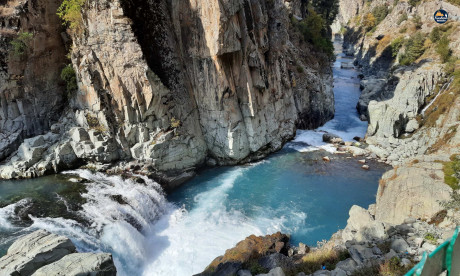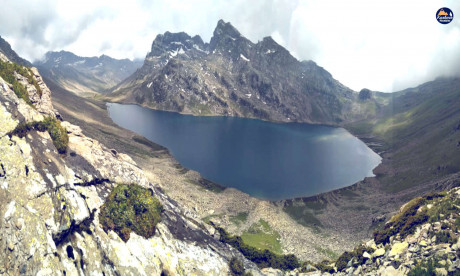Ladakh, a land of surreal landscapes and vibrant cultures, stands as a testament to the awe-inspiring beauty of the Himalayas. Nestled in the northernmost part of India, Ladakh is a high-altitude desert that captivates travelers with its barren yet breathtaking vistas.
1. Leh – The Gateway to Ladakh
Leh, the capital of Ladakh, serves as the primary gateway to this enchanting region. The town is adorned with monasteries, stupas, and traditional Ladakhi architecture. The Leh Palace, Shanti Stupa, and Leh Market are must-visit attractions, offering a glimpse into Ladakh’s rich heritage.
2. Pangong Lake – A Shimmering Wonderland
Pangong Lake, situated at an altitude of 4,350 meters, is a mesmerizing high-altitude lake that spans both India and China. Its crystal-clear waters reflect the surrounding mountains, creating a surreal landscape that changes hues throughout the day. Pangong Lake gained fame through Bollywood film “3 Idiots.”
3. Nubra Valley – The Valley of Flowers
Nubra Valley, known as the “Valley of Flowers,” boasts stunning landscapes with vast stretches of sand dunes, monasteries, and the Nubra River. Hunder, in Nubra, is famous for its double-humped Bactrian camels and offers a unique experience of desert and snow-capped peaks.
4. Tso Moriri Lake – Serenity Amidst the Mountains
Tso Moriri, a high-altitude lake surrounded by snow-capped mountains, is a tranquil destination away from the usual tourist routes. The lake is a paradise for birdwatchers, with a variety of migratory birds flocking to its shores.
5. Magnetic Hill – Defying Gravity
Magnetic Hill is a magnetic phenomenon where vehicles seem to defy gravity and roll uphill. This optical illusion, coupled with the stunning backdrop of the Ladakh Range, attracts curious travelers and adds an element of wonder to the Ladakh experience.
6. Hemis Monastery – A Spiritual Haven
Hemis Monastery, one of the largest and wealthiest monasteries in Ladakh, hosts the vibrant Hemis Festival. The monastery’s ancient architecture, sacred relics, and the annual masked dance festival make it a cultural and spiritual hub.
7. Thiksey Monastery – Majestic Grandeur
Thiksey Monastery, perched on a hill, resembles the Potala Palace in Lhasa, Tibet. The monastery houses a magnificent Maitreya Buddha statue and offers panoramic views of the Indus Valley.
8. Khardung La – The World’s Highest Motorable Pass
For adventure seekers, Khardung La, at an elevation of 5,359 meters, is an iconic destination. It holds the title of the world’s highest motorable pass and offers breathtaking views of the surrounding mountains.
9. Changthang Wildlife Sanctuary – A Habitat for Wildlife
Changthang Wildlife Sanctuary is a haven for wildlife enthusiasts, home to rare species like the Tibetan wild ass (kiang), snow leopards, and various migratory birds.
Ladakh, with its ethereal landscapes and cultural richness, promises an otherworldly experience. Whether exploring ancient monasteries, camping by high-altitude lakes, or navigating mountain passes, Ladakh captivates the soul with its transcendent beauty.
The journey to Ladakh is often described as transcendent, offering a unique experience that combines natural wonders, cultural richness, and a sense of adventure. One of the iconic experiences in Ladakh is the Chadar Trek, a thrilling winter expedition on the frozen Zanskar River.
Chadar Trek: Walking on a Frozen Canvas
The Chadar Trek, also known as the Zanskar Gorge Trek, is a winter trekking adventure like no other. The Zanskar River, which flows through steep canyons, freezes during the winter months, creating a unique trekking trail on a thick sheet of ice. The trek takes adventurers through breathtaking landscapes of towering cliffs, snow-covered mountains, and frozen waterfalls.
Walking on the frozen river, trekkers experience the serenity of Ladakh in its purest form. The stark beauty of the surroundings, the crisp mountain air, and the silence interrupted only by the crunching of snow underfoot create an otherworldly atmosphere. The journey is not just a physical challenge but also a spiritual and cultural immersion into the region’s mystical allure.
Cultural Encounters in Ladakh
Beyond the Chadar Trek, Ladakh offers a tapestry of cultural experiences. The monasteries, or gompas, dotting the landscape are integral to Ladakhi culture. Hemis Monastery, Thiksey Monastery, and Diskit Monastery are among the notable ones, housing ancient scriptures, ornate murals, and vibrant festivals that provide insight into Ladakh’s Buddhist heritage.
The people of Ladakh, known for their warmth and hospitality, add a unique charm to the journey. Interacting with the locals in remote villages unveils a way of life deeply intertwined with the harsh yet harmonious environment. Traditional Ladakhi cuisine, including momos and thukpa, becomes a culinary adventure for the taste buds.
Seasonal Wonders and Challenges
Ladakh’s climate is extreme, with temperatures ranging from scorching summers to freezing winters. The landscape transforms with each season, presenting diverse spectacles. Spring and autumn bring a burst of colors to the barren terrain, while winter turns Ladakh into a snow-covered wonderland.
The region, with its challenging terrain and high altitude, demands careful acclimatization. Travelers need to be prepared for varying weather conditions and practice responsible tourism to preserve Ladakh’s fragile ecosystem.
Embarking on a Ladakh odyssey is not just a journey; it’s a rendezvous with nature’s grandeur and cultural richness. Whether traversing the frozen Zanskar River or exploring ancient monasteries, Ladakh promises an odyssey that transcends the ordinary, leaving indelible memories etched in the heart of every traveler.






